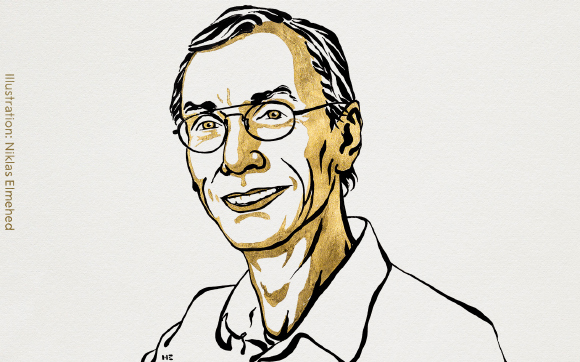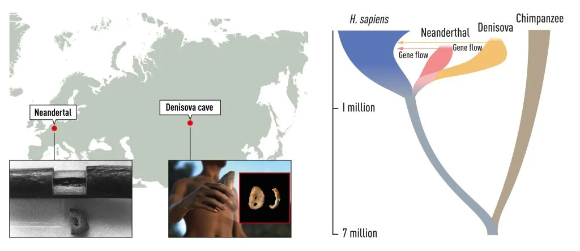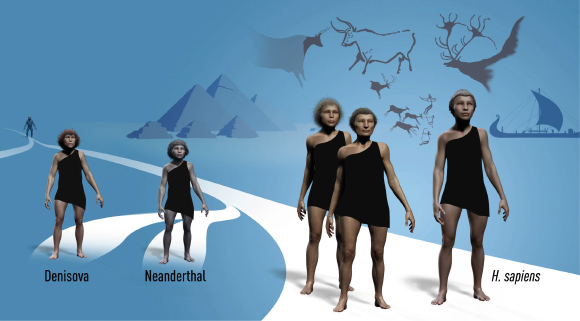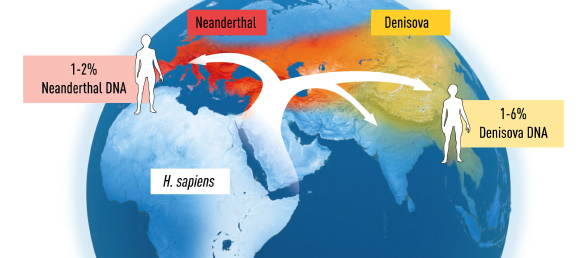The Nobel Prize in Medicine or Physiology will be awarded this year to Svante Pääbo, who is considered the father of paleogenetics, for his discoveries in the field of genomes of extinct species in the human lineage
Where did we come from? Who were our ancestors? What happened to our relatives who lived in the past and became extinct? These questions have always fascinated mankind, but until recently, the only way to find answers for them was to study the anatomical features of the fossils found. Svante Pääbo, who will be awarded the Nobel Prize in Physiology or Medicine this year, and his colleagues were able to extract genetic material from fossils of Neanderthals, archaic humans that were very closely related to us. In doing so they greatly expanded our knowledge of these people and about our evolution. The genetic studies have even uncovered a population of ancient humans that were previously unknown to science - the Denisovans. They were also able to demonstrate that both Neanderthals and Denisovans met with the forefathers of modern humans, and that most humans alive today carry DNA from these ancient populations within their cells.
The Neanderthal Mystery
Neanderthals first emerged roughly 400 thousand years ago, and disappeared about 40 thousand years ago. This means that there was a considerable overlap between them and our own species, Homo sapiens, who first appeared about 200 to 300 thousand years ago. And yet, for a substantial part of this time period they were separated geographically: Homo sapiens evolved in Africa, whereas Neanderthals most likely never reached it. They lived in Southern and Central Europe, Central Asia and the Middle East. Contrary to previous conventions, Neanderthals were not our ancestors, but rather our cousins: both of us evolved from a common ancestor. 
The Nobel Prize in Medicine or Physiology will be awarded this year to Svante Pääbo, for his research in the field of the genomes of extinct species in the human lineage | Illustration: The Nobel Prize official website
About one hundred thousand years ago, and probably even earlier, our species began leaving Africa and reached the region of the Middle East, where they likely met with the Neanderthals. What was the nature of their relations? This question was difficult to answer based on bones and stone tools, and thus, the answer had to wait for genetic research - and for Svante Pääbo.
Ancient DNA
The genetic material, DNA, cannot survive forever. With the progress of time, it breaks down into its building blocks, and all of the genetic information that is stored in it is lost. The maximum amount of time that still allows to extract relatively intact DNA segments from a sample is dependent on the conditions in which they were sustained and on the initial amount of genetic material. Mammoth teeth that were found in permafrost, for example, were so well preserved that it was possible to extract genetic material from them over a million years later. In warmer places, DNA degrades faster.
One of the methods to increase the chances of finding ancient genetic material is to look for DNA that is highly concentrated in cells. Most of our DNA is found in the cell’s nucleus: this is the main genetic storage of the cell, and includes most of what we usually think of when we speak of our genome. But this is not the only place in the cell where DNA can be found. Our cells also contain mitochondria (mitochondrion in singular form), organelles that are responsible for the breakdown of sugars and for energy production, and have their own DNA. While the nucleus contains more DNA than any of the organelles, there are thousands of mitochondria in each and every cell, and each of them carries a copy of mitochondrial DNA. That is why there are many more copies of this DNA in our body, which makes it more simple to extract from ancient samples.
In addition, if there is any DNA left in the sample, its content can be amplified using the PCR method, which allows for amplification of single DNA fragments even when only very few copies are present in the sample. In 1987, shortly after this method was invented, Pääbo moved to the University of California, Berkeley, in the United States. There he continued his research on ancient DNA and was the first to apply the PCR method to ancient samples. It was very effective, but also increased the risk of contamination - since even if trace amounts of the researcher’s own DNA reached the sample, the PCR could duplicate it. And so, Pääbo began working on methods for prevention of contaminations, such as clean rooms. His goal, already at the time, was to extract genetic material from a Neanderthal bone.

Genetic material extracted by Pääbo from bones found in the Neander Valley, and later from the Denisovan Cave, revealed the evolutionary and genetic connection between modern humans and our ancient relatives | Mattias Karlén, © The Nobel Committee for Physiology or Medicine
Neanderthal Genes
In 1990 Pääbo began working at Munich University in Germany. There he obtained access to Neanderthal fossils, and not just any fossils: the bones that were found in the Neander Valley near Dusseldorf in 1856, after which the species was named. The bones are kept in a museum in the city of Bonn, and its curators granted Pääbo access to a part of an arm bone on which he was able to work. In July 1997 Pääbo and colleagues published the sequence of a portion of Neanderthal mitochondrial DNA: the first sample of genetic material to be extracted from an extinct human.
The researchers compared the mitochondrial DNA of Neanderthals with that of modern humans, but to fully understand the differences between populations, the nucleic DNA would be required. Only this way will it be possible to compile the Neanderthal genome, and to examine the differences and similarities between it and the genome of modern humans. This breakthrough came several years later, when Pääbo worked at the Max Planck Institute for Evolutionary Anthropology in Leipzig, Germany. This time Pääbo worked on Neanderthal bones found at Vindija Cave in Croatia, which were dated to about 40 thousand years before our time. These were some of the “youngest” bones that we have, and so there are greater chances of finding DNA in them. Pääbo and his colleagues used novel algorithms, which were especially developed to analyze and compile the segments of DNA that were produced from bones of three different individuals. In 2010 the researchers published an initial draft sequence of the Neanderthal genome. The knowledge we had of our extinct relatives increased immeasurably - and also, we almost immediately found new and surprising information regarding ourselves.
Pääbo compared the Neanderthal genome to the genome of modern people from different places - starting with West Africa, Europe and East Asia, and later from other places. He found that Neanderthals were closer genetically to non-Africans than to Africans - a finding that suggests gene transfer between the ancestors of modern humans and Neanderthals, after they left Africa. Or in other words, the ancestors of Europeans, Asians and anyone that is not African produced offspring with Neanderthals. Some of these offspring grew with their human relatives and procreated with them, and thus inserted their Neanderthal genes into the population. As a result, about one to four percent of the modern non-African human genome comes from Neanderthals.
Although fossils of Neanderthals were found in Europe and West Asia, modern Europeans are not more closely related to Neanderthals than people who live in East Asia. From this the researchers concluded that the encounter with Neanderthals occurred near the time of the exodus from Africa, maybe even right here in the Middle East, and before the European and Asian populations separated.

The DNA uncovered a new genetic population, closer to Neanderthals but different from them: the Denisovans. The evolutionary tree of modern humans (right), Neanderthals and Denisovans | Illustration: Mattias Karlén, © The Nobel Committee for Physiology or Medicine
A New Man
Two years prior to this discovery, in 2008, Pääbo and his team extracted mitochondrial DNA from a fragment of a finger bone found in the Denisova Cave in Siberia. Human bones and stone tools that were associated with Neanderthals were found in the cave, but the DNA that was found was different from the Neanderthal mitochondrial DNA seen in previous studies. The researchers found genetic evidence for the existence of a separate population of archaic humans, distinct from Neanderthals and from modern humans. The evidence for the existence of the Denisovan man, as it was called, was reinforced in 2010, when Pääbo and colleagues published the genomic sequence of this human, using DNA extracted from the same finger bone fragment. It was the first time that a different type of human was identified purely on the basis of its genetic sequence, without any actual evidence in the fossils.
It soon became clear that Denisovans also contributed genes to modern humans, but to a smaller population - mainly to the inhabitants of the Melanesian Islands. Later studies found Denisovan genes in other Asian populations as well as in Native Americans, who originated from East Asia.
In recent years Pääbo’s group continued to extract DNA from ancient bones. They demonstrated that teeth found in the Denisova Cave also belonged to Denisovans, and also found a bone that belonged to a hybrid - a woman whose mother was a Neanderthal and whose father was a Denisovan. It appears that gene exchanges between the different hominin populations also occurred when our ancestors were not around.
The researchers published DNA sequences of Neanderthals from additional locations, as well as those of the ancestors of modern humans. In 2017 they even succeeded to extract mitochondrial DNA of Neanderthals and Denisovans from sediment samples that were taken from caves in Siberia and Europe, and in 2021 they succeeded to extract nucleic DNA from similar samples. The ability to analyze nuclear DNA from soil sediments, rather than settling for the few fossils we have, “massively extends the range of options to tease out the evolutionary history of ancient humans”, said Benjamin Vernot, who led the research.
The Paleogenetics that Started a Revolution
As more genetic studies were published, it became clearer how convoluted the story of human origin is, with different populations maintaining intertwined relations with one another. With his studies Pääbo founded a new research field, Paleogenetics, the science of ancient genetics, which changed our perception of human evolution. Within about ten years, we discovered the tight genetic link between us and the Neanderthals, we found a new population of humans that could not have been discovered without DNA, and gained much knowledge of our own genetics, and through it gained knowledge of the history of our species. Researchers from different fields make use of the large genetic database created by Pääbo and his colleagues, to answer many questions that could not have been asked before.
Some of these questions relate to present day humans. One example is Denisovan genes that were identified in various human populations, and affect their anatomy. An international research team, which included two professors from the Hebrew University, found that a gene of Denisovan origin is common among Inuit people and helps them to cope with cold conditions, while, according to a different research, another gene of Denisovan origin helps the residents of the Tibetan high plains to live at extremely high altitudes, despite the thin air.
One question that hitherto has no clear answer is the question as to why did the Neanderthals become extinct. Did our ancestors, who were more numerous and lived in larger groups, compete with them for resources, and win? Maybe they even engaged in direct fight? Pääbo suggests another alternative, following the discoveries that showed multiple gene exchanges between populations: not competition, but rather absorption. “Maybe Neanderthals and Denisovans were absorbed into the modern human populations,” said Pääbo in a 2018 interview to the New-York Times. “That could be a big part of the story” he concluded.

As more and more genetic studies were published, it became clear how convoluted the story of human origin is. An illustration of the migration of modern humans from Africa and the genes they collected along the way | Illustration: Mattias Karlén, © The Nobel Committee for Physiology or Medicine
Intertwined Relations
Pääbo was born in Stockholm, Sweden, in 1955, and was raised by his mother Karine, who was a refugee from Estonia. Karine worked for a while as a chemist at the lab of Sune Bergström, who was later awarded the 1982 Nobel Prize in Physiology or Medicine, together with two other scientists. A lab affair between Karine Pääbo and the married Bergström, resulted in the birth of Svante, in the same year in which a son was born to Bergström and his wife. On Saturdays Bergström would visit Pääbo, and travel with him to places in which he thought he would not be recognized.
In 1886, Pääbo completed his doctoral studies at Uppsala University in Sweden. At the beginning of his university studies he studied Egyptology, having been fascinated by mummies, but having discovered that his studies would mainly include hieroglyphics he switched to medicine, and finally to cell biology. Following his graduation he continued for post-doctoral studies at the University of Zurich in Switzerland and then at University of California, Berkeley, in the United States. In 1990 he was accepted as professor at the University of Munich, Germany. In 1999 he founded the Max Planck Institute for Evolutionary Anthropology in Leipzig, Germany, where he still works to this day.
In Berkeley Pääbo, who considered himself a homosexul, met Linda Vigilant, an American primatologist and geneticist. They met again when both of them moved to Leipzig, which led to an affair between Pääbo and Vigilant, who was then married to a close colleague and collaborator or Pääbo. They have since co-authored many scientific papers, were married in Hawaii and are raising a son and a daughter together (Vigilant also has two sons from her previous marriage). In his 2014 book Neandethal Man: In Search of Lost Genomes, Pääbo wrote that he defines himself as bisexual.
Pääbo received many awards for his research, including the Breakthrough Prize in Life Sciences (2016), the Darwin–Wallace Medal (2019), the Japan Prize (2020) and the Massry Prize (2021).
